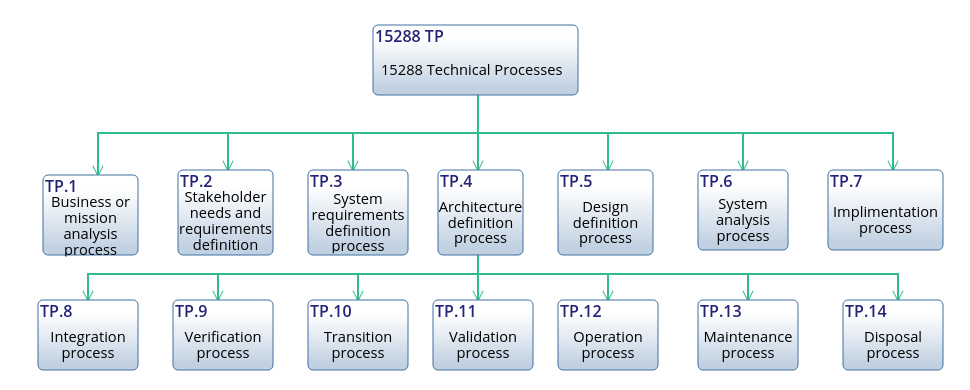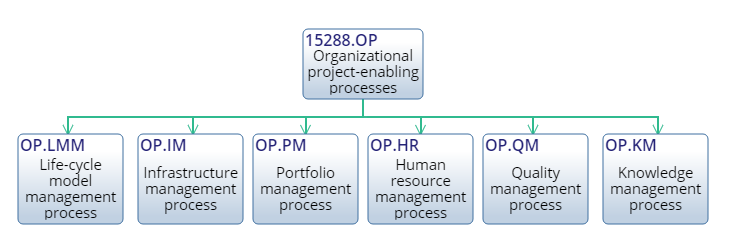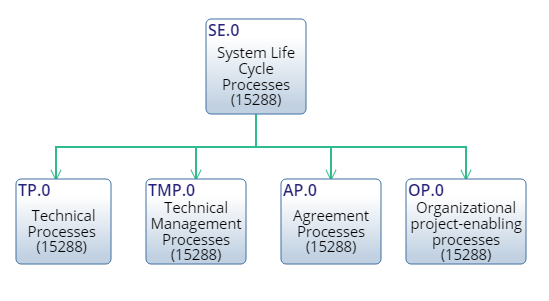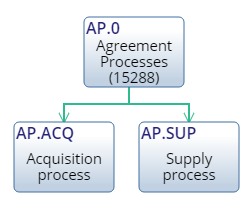Introduction
This article provides introduction and overview of Systems and software engineering - System life cycle processes (ISO/IEC/IEEE 15288 :2015) as published under a joint project by ISO, IEC, and IEEE. The goal of this article is to establish for the reader awareness of the publication and its contents as a significant source of information on systems engineering.
Citation Information:
ISO/IEC/IEEE (2015). 15288:2015 System and software engineering - System life cycle processes.ISO/IEC Joint Technical Committee and IEEE Standards Coordinating Committee. Geneva and New York.
Standard can be previewed and purchased at http://www.iso.org/obp/ui/
15288:2015 Topics
Overview (Chapter 1)
The goal of the 15288:2015 standard is to establish a common lexicon for the activities executed within a systems engineering endeavor. The intended audience of the standard are those in the practice and leadership of systems engineering. This audience may include operations analysts, system architects, engineers, systems developers, computer scientists and project managers (ISO/IEC/IEEE 15288:2015).
ISO/IEC/IEEE Standard 12207:2015 applies to Software life cycles. The processes and lexicons within these two standards are consistent.
INCOSE 2015, Systems Engineering Handbook adopts and expands upon the life cycle processes defined in 15288:2015. See CABoK articles on the INCOSE Systems Engineering Handbook and Systems Engineering Overview.
Normative References (Chapter 3)
- None Listed
SE Lexicon (Chapter 4)
Section 4 of 15288:2015 lists the key terms, definitions and abbreviated terms used within the standard. These terms are also reflected in ISO/IEC/IEEE 24765 Systems and software engineering - Vocabulary available at the SEVOCAB Site. The adaption of a common lexicon for a project is an important best practice recommended my multiple professional organizations. Project team leaders should ensure that the team and the team's products use a common dictionary based on a published source or sources.
CABoK uses the SEVOCAB site as its principle dictionary. In doing so, this body of knowledge is constant with INCOSE 2015, ISO/IEC/IEEE 15288:2015 and ISO/IEC/IEEE 24765.
See Project Communications Best Practices for more information on the selection of a project lexicon and dictionary(s).
The 2015 revisions to 15288 were performed in parallel to updates to ISO/IEC/IEEE Systems and software engineering - software life cycle processes 12207:2017 in order to establish consistency between the two standards.
Key Concepts of the Standard (Chapter 5)
System Concepts (5.2)
- System Definitions
- System Structure
- Enabling Systems
Organizations and Project Concepts (5.3)
- Organizational Level Adoption
- Project Level Adoption
Systems Life Cycle (5.4)
- System Life Cycle Model
- System Life Cycle Stages
ISO/IEC/IEEE 15288:2015 references phases defined in ISO/IEC TR 24748-1 which lists the generic phases of the systems life cycle as: concept, development, production, utilization, support and retirement. Figure 1 depicts these phases.

A systems engineering endeavor involves the execution of the technical, technical management and agreement activities during each phase of the lifecycle depicted in Figure 1. This standard points out several key points about SE activities, organizations and the systems lifecycle:
- Figure 1 implies a sequence of the phases within the lifecycle, however these phases often overlap and are recursive.
- The phases depicted are generic and may not fully define all phases of a system's maturation.
- The activities depicted in Figure 1 and Figures 3 and 4 below may be executed multiple times across multiple phases of the life cycle.
- The methods in which a life cycle can be executed in numerous based on factors such as level of up front planning, clarity of the problem space, urgency to achieve incremental capabilities and funding streams.
See Systems Life Cycle for more information on life cycle models
Process Concepts
- Criteria for processes
- Description of processes
- Characteristics of a process
- Process Tailoring
- Processes in the Standard
System Life Cycle Processes (Chapter 6)
The 15288 Agreement Process area is similar to the PMBOK Project Procurement Management Knowledge Area which includes the process areas: Plan Procurement Management, Conducting Procurement and Controlling Procurement knowledge areas within the PMI Project Management Body of Knowledge (PMBoK) (PMI 2017).
The Organizational Process Area area is analogous to the Organizational Process Assets within the PMBoK (PMI 2017).
Technical Processes
The technical processes of 15288: 2015 describe the activities directly associated with the definition, design, development, delivery and support of the system. Each process plays a role in the end to end life cycle of a system. Remember that a SE team should apply all of theses processes in the development of a systems solution regardless of the problem or the solution. What changes from project to project is the level of effort and complexity of engineering data created for the project. The Activity Hierarchy Model in Figure 3 represents the processes depicted in Figure 1.

See INCOSE Systems Engineering Handbook for amplifying information on the applications of these processes.See Systems Engineering: Technical Processes for elaboration of each technical process.
Technical Management Processes
See INCOSE Systems Engineering Handbook for amplifying information on the applications of these processes.See Systems Engineering: Technical Management Processes for elaboration of each management process.
Agreement Processes
The 15288 Agreement Process area is similar to the PMBOK Project Procurement Management Knowledge Area which includes the process areas: Plan Procurement Management, Conducting Procurement and Controlling Procurement knowledge areas within the PMI Project Management Body of Knowledge (PMBoK) (PMI 2017).
See INCOSE Systems Engineering Handbook for amplifying information on the applications of these processes.See Systems Engineering: Agreement Processes for elaboration of each agreement process.
Organization Project Enabling Processes

The Organizational Process Area area is analogous to the Organizational Process Assets within the PMBoK (PMI 2017).
See INCOSE Systems Engineering Handbook for amplifying information on the applications of these processes.See Systems Engineering: Organizational Project Enabling Processes for elaboration of each agreement process.
Tailor Process (Annex A)
Example Process Information items (Annex B)
Process Reference Model for Assessment Purposes (Annex C)
Process Integration and Process Constructs (Annex D)
Process Views (Annex E)
Architecture Modeling (Annex F)
Application of System Life Cycle Process to a System of Systems (Annex G)


